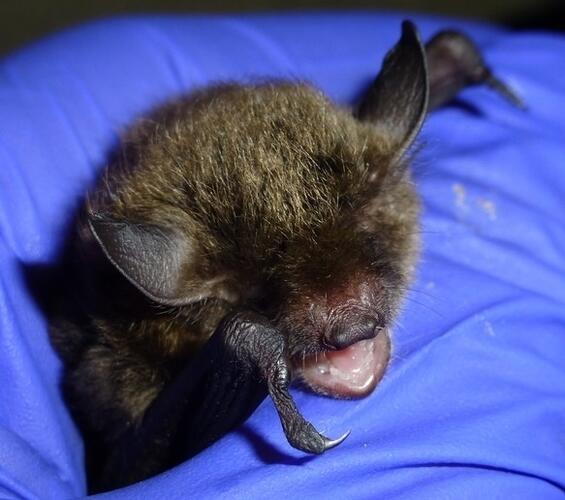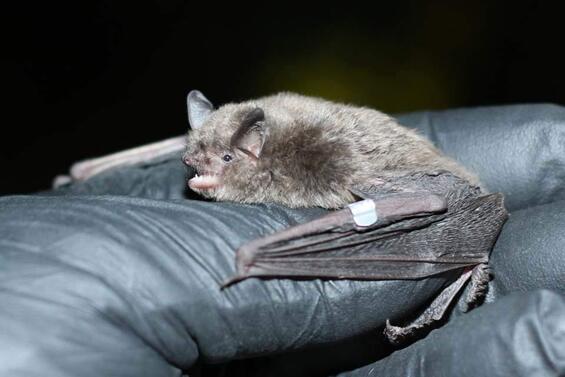- Scientific name: Myotis sodalis
- Species of Greatest Conservation Need (MA State Wildlife Action Plan)
- Endangered (MA Endangered Species Act)
- Endangered (US Endangered Species Act)
Description

Indiana bat (Myotis sodalis)
The Indiana bat (or Indiana myotis) is an insectivorous, migratory bat of medium size (about 83 mm (3.25 in) in total length). It has loose, fluffy, and finely textured fur with an overall appearance of dull chestnut-gray above with pinkish white below. The tragus (a specialized ear projection) is short and blunt, the feet are small, and the calcar (the cartilage support at outer edge of tail membrane) is strongly keeled.
Similar species: The Indiana bat resembles the little brown bat (Myotis lucifugus), but the latter species has more conspicuous toe hairs, longer hind feet, and a mostly unkeeled calcar. The Indiana bat also has a distinctive pinkish-brown color of fur, which in good light distinguishes it from other Myotis in its range most of the time.
Life cycle and behavior
In summer, female Indiana bats with young roost together in maternity colonies. These small summer colonies, ranging from a couple to a few dozen bats, are usually under the loose bark of standing dead trees, but occasionally are under the bark of live trees, particularly shagbark hickory, or in cavities. Female bats bear one young per year, in late June. The young bats are weaned in about a month and can be flying by mid-July. Male bats and females with no young roost elsewhere in small colonies in summer. Indiana bats begin migrating back to their winter hibernacula as early as late July, but most arrive back in September and October. Breeding usually occurs as the bats settle into their hibernacula, but may occur in spring, as well.Unlike many bat species that hibernate in North America, nearly all Indiana bats hibernate in just a few select caves and abandoned mines. These large aggregations of hibernating bats are very susceptible to disturbance by humans in winter and, in recent years, to infection with white-nose syndrome.
White-nose syndrome is caused by Pseudogymnoascus destructans, a fungal species new to science, but closely related to fungi that naturally grow in caves. The fungus grows over bats while they hibernate, causing them to rouse from dormancy frequently, lose valuable stored fat, and fail to survive the winter. The fungus is believed to be passed from cave to cave primarily by the movements of breeding male bats, but human transport is also thought to be responsible for the infection of some hibernacula in the U.S.
In spring, the bats emerge from their hibernacula in April and May and begin migrating to their summer feeding areas.
Population status

Indiana bat (Myotis sodalis)
The Indiana bat is listed as endangered under the Massachusetts Endangered Species Act. All listed species are protected from killing, collecting, possessing, or sale and from activities that would destroy habitat and thus directly or indirectly cause mortality or disrupt critical behaviors. In addition, listed animals are specifically protected from activities that disrupt nesting, breeding, feeding, or migration.
Distribution and abundance
The Indiana bat ranges from Vermont and New York, and west through Michigan to Iowa, Missouri, and Arkansas, and south to Mississippi, Alabama, and Georgia. Northern populations migrate south to wintering hibernacula; currently, this species hibernates in Indiana, Kentucky, and Missouri. About half of all Indiana bats hibernate in southern Indiana in a few caves.
Habitat
In winter, the bats hibernate in caves and abandoned mines. The last known observation of an Indiana bat in Massachusetts was in 1938. Formerly, it was known to hibernate at sites in Berkshire and Hampden counties.
Healthy habitats are vital for supporting native wildlife and plants. Explore habitats and learn about conservation and restoration in Massachusetts.
Threats
The greatest known threat to Indiana bats in Massachusetts is the white-nose syndrome. The U.S. Fish & Wildlife Service is working with government and non-profit groups to understand the spread of the fungus and potentially stop its spread.
Conservation
Massachusetts has always been on the very edge of the range of the Indiana bat. Records of this species only range from 1935 to 1938. However, they probably did occur in Massachusetts for some time before they were first recognized. An earlier reported specimen from 1931 is actually a little brown bat. From the 1940s–1960s, Indiana bats declined, and their range shrunk away from Massachusetts. Before the arrival of white-nose syndrome, the numbers of Indiana bats were increasing in eastern New York and Vermont bringing optimism that they might return to Massachusetts.
The best management support we can now provide is access to suitable, undisturbed hibernacula which is essential to the survival of the Indiana bat, and protection of known sites is paramount. Human disturbance of the most important hibernacula can be discouraged or prevented with the use of gated entrances, to avoid disturbances that cause the arousal of hibernating bats.
References
MassWildlife. 2020. Homeowner’s Guide to Bats. Massachusetts Department of Fisheries & Wildlife: Westborough, MA. 26 pp.
U.S. Fish & Wildlife Service. 2007. Indiana Bat (Myotis sodalis) Draft Recovery Plan: First Revision.
U.S. Fish & Wildlife Service. 2012. “Indiana Bat (Myotis sodalis).”
U.S. Fish & Wildlife Service. 2012. “White-nose Syndrome.”
Whitaker, J.O., Jr. and W.J. Hamilton, Jr. 1998. Mammals of the Eastern United States, Third Edition. Cornell University Press, Ithaca, NY. 583 pp.
Contact
| Date published: | March 4, 2025 |
|---|